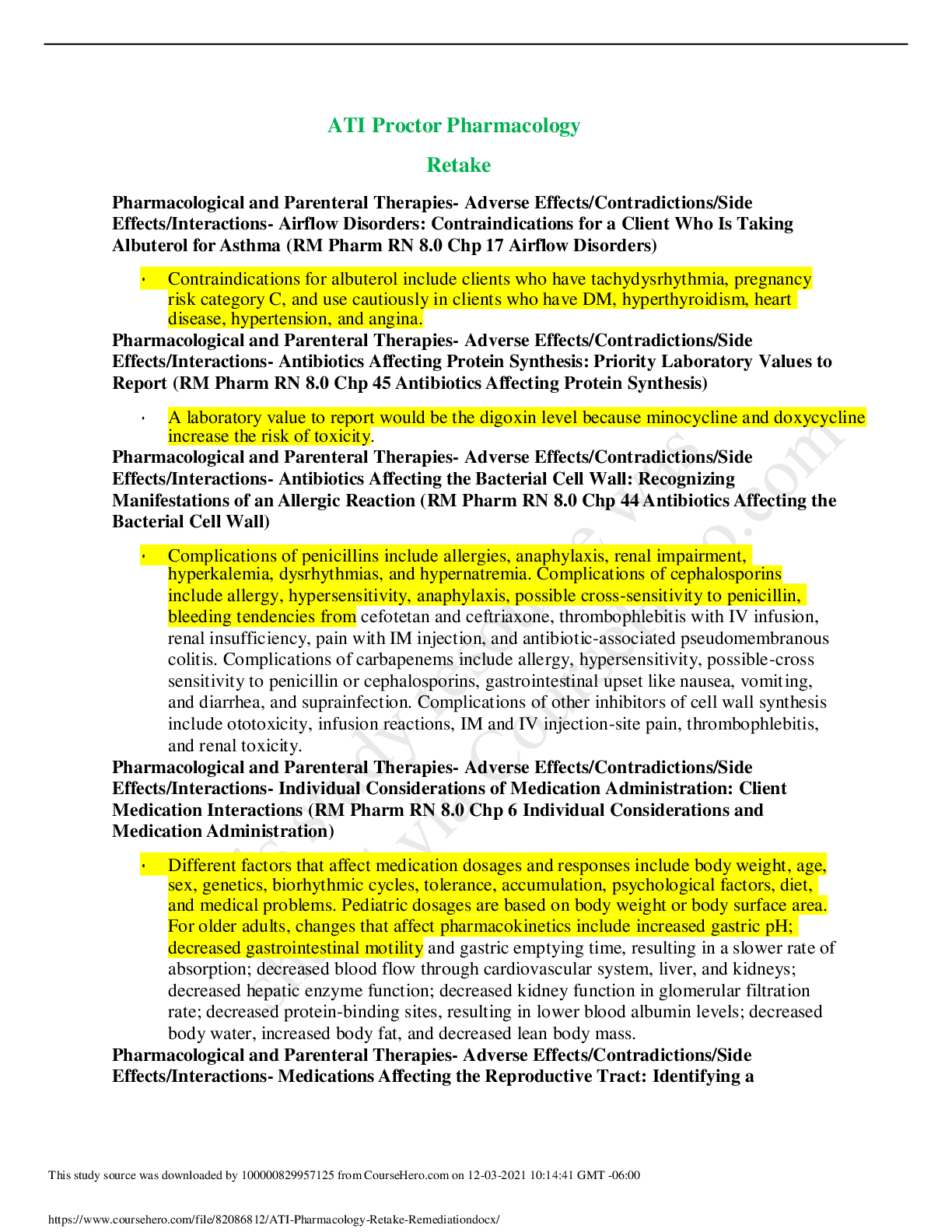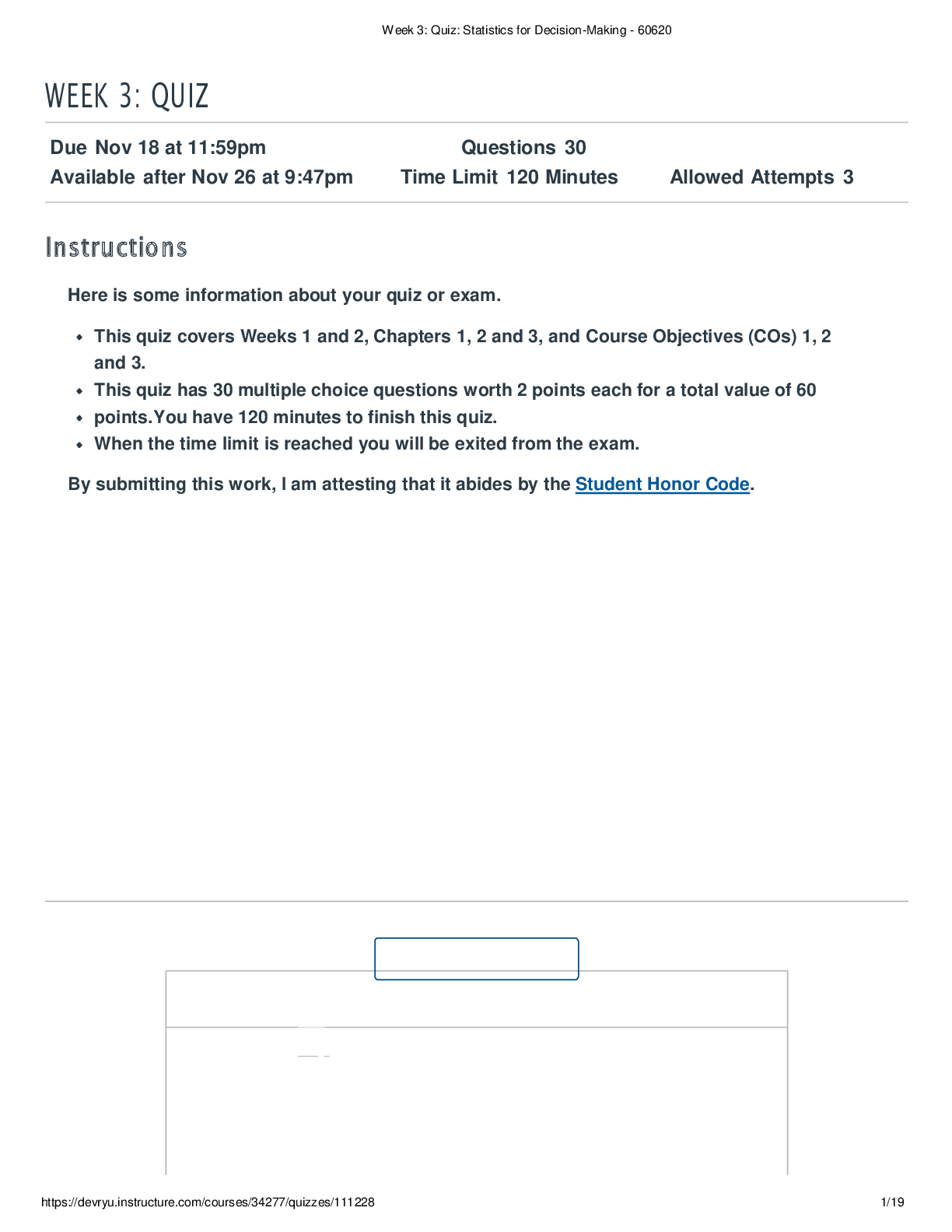*NURSING > EXAM > ATI Proctor Pharmacology Retake (GRADED A) Questions and Answers | 100% VERIFIED. (All)
ATI Proctor Pharmacology Retake (GRADED A) Questions and Answers | 100% VERIFIED.
Document Content and Description Below
ATI Proctor Pharmacology Retake Pharmacological and Parenteral Therapies- Adverse Effects/Contradictions/Side Effects/Interactions- Airflow Disorders: Contraindications for a Client Who Is Taking Al... buterol for Asthma (RM Pharm RN 8.0 Chp 17 Airflow Disorders) • Contraindications for albuterol include clients who have tachydysrhythmia, pregnancy risk category C, and use cautiously in clients who have DM, hyperthyroidism, heart disease, hypertension, and angina. Pharmacological and Parenteral Therapies- Adverse Effects/Contradictions/Side Effects/Interactions- Antibiotics Affecting Protein Synthesis: Priority Laboratory Values to Report (RM Pharm RN 8.0 Chp 45 Antibiotics Affecting Protein Synthesis) • A laboratory value to report would be the digoxin level because minocycline and doxycycline increase the risk of toxicity. Pharmacological and Parenteral Therapies- Adverse Effects/Contradictions/Side Effects/Interactions- Antibiotics Affecting the Bacterial Cell Wall: Recognizing Manifestations of an Allergic Reaction (RM Pharm RN 8.0 Chp 44 Antibiotics Affecting the Bacterial Cell Wall) • Complications of penicillins include allergies, anaphylaxis, renal impairment, hyperkalemia, dysrhythmias, and hypernatremia. Complications of cephalosporins include allergy, hypersensitivity, anaphylaxis, possible cross-sensitivity to penicillin, bleeding tendencies from cefotetan and ceftriaxone, thrombophlebitis with IV infusion, renal insufficiency, pain with IM injection, and antibiotic-associated pseudomembranous colitis. Complications of carbapenems include allergy, hypersensitivity, possible-cross sensitivity to penicillin or cephalosporins, gastrointestinal upset like nausea, vomiting, and diarrhea, and suprainfection. Complications of other inhibitors of cell wall synthesis include ototoxicity, infusion reactions, IM and IV injection-site pain, thrombophlebitis, and renal toxicity. Pharmacological and Parenteral Therapies- Adverse Effects/Contradictions/Side Effects/Interactions- Individual Considerations of Medication Administration: Client Medication Interactions (RM Pharm RN 8.0 Chp 6 Individual Considerations and Medication Administration) • Different factors that affect medication dosages and responses include body weight, age, sex, genetics, biorhythmic cycles, tolerance, accumulation, psychological factors, diet, and medical problems. Pediatric dosages are based on body weight or body surface area. For older adults, changes that affect pharmacokinetics include increased gastric pH; decreased gastrointestinal motility and gastric emptying time, resulting in a slower rate of absorption; decreased blood flow through cardiovascular system, liver, and kidneys; decreased hepatic enzyme function; decreased kidney function in glomerular filtration rate; decreased protein-binding sites, resulting in lower blood albumin levels; decreased body water, increased body fat, and decreased lean body mass. Pharmacological and Parenteral Therapies- Adverse Effects/Contradictions/Side Effects/Interactions- Medications Affecting the Reproductive Tract: Identifying a Contraindication for Receiving Sildenafil (RM Pharm RN 8.0 Chp 31 Medications Affecting the Reproductive Tract) • Sildenafil use for erectile dysfunction augments the effects of nitric oxide released during sexual stimulation, resulting in enhanced blood flow to the corpus cavernosum and penile erection. Contradicted in clients taking any medications in the nitrate family (nitroglycerin) and use caution in clients who has cardiovascular disease, including QT prolongation. Pharmacological and Parenteral Therapies- Adverse Effects/Contradictions/Side Effects/Interactions- Miscellaneous Pain Medications: Adverse Effects of Ergotamine (RM Pharm RN 8.0 Chp 38 Miscellaneous Pain Medications) • Adverse effects include gastrointestinal discomfort, acute or chronic toxicity, physical dependence, and/or fetal harm or abortion. Pharmacological and Parenteral Therapies- Adverse Effects/Contradictions/Side Effects/Interactions- Non-Opioid Analgesics: Identifying Contraindications (RM Pharm RN 8.0 Chp 35 Nonopioid Analgesics) • Contraindications for first-generation NSAIDs include pregnancy, peptic ulcer disease, bleeding disorders, hypersensitivity to aspirin and other NSAIDs, and aspirin is contraindicated in children and adolescents who have a viral illness. Ketorolac is contraindicated in clients who have advanced kidney disease. Contraindications for acetaminophen include pregnancy risk category B for oral, rectal use, and C for IV use. Avoid in clients who have hypersensitivity to a component, or severe liver impairment or disease, kidney impairment, chronic alcohol use disorder, malnutrition, and use the IV form cautiously for clients who are breastfeeding. Pharmacological and Parenteral Therapies- Pharmacological Pain Management- Individual Considerations of Medication Administration: Risk Factors for Adverse Reactions in Older Adult Clients (RM Pharm RN 8.0 Chp 6 Individual Considerations and Medication Administration) • Older adults with reduced liver and kidney function require proportionately smaller medication doses to compensate for their heightened sensitivities to medications. In older adults, decreased kidney and liver function are the major causes of medication accumulation leading to toxicity. Due to the decreased GI motility and gastric emptying time, there is a slower rate of absorption of medications. Pharmacological and Parenteral Therapies-Medication Administration- Antibiotics Affecting the Bacterial Cell Wall: Contraindications for Client Who Has Anaphylactic Reaction to Penicillin (RM Pharm RN 8.0 Chp 44 Antibiotics Affecting the Bacterial Cell Wall) • A history of severe allergic reactions to penicillin, cephalosporins, or imipenem is a contradiction for penicillins, use cautiously for clients who have or are at risk for kidney dysfunction (clients who are acutely ill, older adults, or young children). Clients who are allergic to one penicillin are cross-allergic to other penicillins and are at risk for cross- sensitivity to cephalosporins. Pharmacological and Parenteral Therapies-Medication Administration- Bipolar Disorders: Intervention for a Lithium Level (2019 review modules, RM Pharm RN 8.0, RM Pharm RN 8.0 Chp 9 Bipolar Disorders) • Maintain a diet adequate in sodium and intake at least 1.5 to 3 L of water daily from food and beverage sources. Pharmacological and Parenteral Therapies-Medication Administration- Medications Affecting Coagulation: Clarifying a Prescription With Provider (RM Pharm RN 8.0 Chp 25 Medications Affecting Coagulation) • Discuss concurrent use of CoQ-10 and warfarin with the provider due to both having a similar structure to vitamin K. Pharmacological and Parenteral Therapies-Medication Administration- Vitamins and Minerals: Administration of Ferrous Sulfate Elixir (RM Pharm RN 8.0 Chp 30 Vitamins and Minerals) • Parenteral forms should only be used in clients who are unable to take oral medications. In this case, IV is preferred. Iron is poorly absorbed in the body so large amounts must be ingested orally to increase hemoglobin and hematocrit levels. Iron preparations are used to prevent iron deficiency anemia for clients who are at an increased risk. Pharmacological and Parenteral Therapies- Dosage Calculation- Dosage Calculation: Administering Sulfadiazine Tablets in Divided Doses (RM Fund 10.0 Chp 48 Dosage Calculation) • It is important for nurses to be able to to do basic medication dose conversion and calculation to correctly administer the correct amount of medication. There are different methods to do dosage calculation. My preferred method is the use of formula (desired over have). Example: A nurse is preparing to administer phenytoin 0.2g PO every 8hr. The amount available is phenytoin 100mg/capsule. How many capsules should the nurse administer per dose? We are calculating how many capsules. The desired dose to administer is 0.2g the dose available is 100mg. First must convert 0.2g to mg. 0.2g x 1000mg= 200mg. the equation will be xcapsules= 200mg/100mg x 1 capsule. After solving for X you should get 2. The nurse will administer 2 capsules PO. Pharmacological and Parenteral Therapies- Expected Actions/Outcomes- Diabetes Mellitus: Evaluating Adherence to the Treatment Plan (RM Pharm RN 8.0 Chp 39 Diabetes Mellitus) • When using incretin mimetics effectiveness can be evidenced by preprandial glucose levels 90 to 130 mg/dL and postprandial levels less than 180mg/dL and a HbA1c less than 7%. Clients with diabetes mellitus need to have their blood glucose and HbA1c checked regularly to ensure adherence to medication regimen and that the medication is effective. Pharmacological and Parenteral Therapies- Expected Actions/Outcomes- Endocrine Disorders: Evaluating Therapeutic Effect of Levothyroxine (RM Pharm RN 8.0 Chp 40 Endocrine Disorders) • Decreased TSH levels and absence of hypothyroidism manifestations. Pharmacological and Parenteral Therapies- Expected Actions/Outcomes- Endocrine Disorders: Identifying Need for Dosage Adjustment of Methimazole (RM Pharm RN 8.0 Chp 40 Endocrine Disorders) • Methimazole is considered first-line treatment for Graves’ disease. Overmedication can result in manifestations of hypothyroidism. Reduce the dose and/or temporary administration of thyroid supplements can be needed. Monitor PT, INR, and aPTT. Adjust the dosages of the anticoagulants accordingly. Monitor digoxin level and reduce digoxin dose as needed. Pharmacological and Parenteral Therapies- Expected Actions/Outcomes- Medications Affecting Coagulation: Treatment for Deep-Vein Thrombosis (RM Pharm RN 8.0 Chp 25 Medications Affecting Coagulation) • Heparin prevents clotting by activating antithrombin and indirectly inactivates thrombin and factor Xa. This inhibits fibrin formation. Low molecular weight heparins prevent DVT in post op clients. While the client is on heparin therapy, monitor aPTT, platelet count, and hematocrit levels after obtaining baselines. Use an infusion pump for continuous IV administration. Monitor aPTT every 4 to 6 hours until appropriate dose is determined, then monitor daily. Physiological Adaptation- Fluid and Electrolyte Imbalances- Fluid Imbalances: Identifying Manifestations of Fluid Volume Deficit (RM Fund 10.0 Chp 57 Fluid Imbalances) • Findings of dehydration include hypothermia or hyperthermia, tachycardia, thready pulse, hypotension, orthostatic hypotension, decreased CVP, tachypnea, hypoxia, dizziness, syncope, confusion, weakness, fatigue, seizures, thirst, dry mucous membranes, dry furrowed tongue, nausea, vomiting, anorexia, acute weight loss, oliguria, diminished capillary refill, cool clammy skin, diaphoresis, sunken eyeballs, flattened neck veins, absence of tears, and decreased skin turgor. Laboratory tests that can show a deficit include hematocrit, blood osmolarity, urine specific gravity, blood sodium, and BUN. Physiological Adaptation- Fluid and Electrolyte Imbalances- Vitamins and Minerals: Evaluating Effectiveness of Sodium Polystyrene Sulfonate (RM Pharm RN 8.0 Chp 30 Vitamins and Minerals) • The potassium levels are lower than 5.0 mEq/L. [Show More]
Last updated: 1 year ago
Preview 1 out of 4 pages
Instant download

Buy this document to get the full access instantly
Instant Download Access after purchase
Add to cartInstant download
Reviews( 0 )
Document information
Connected school, study & course
About the document
Uploaded On
Dec 03, 2021
Number of pages
4
Written in
Additional information
This document has been written for:
Uploaded
Dec 03, 2021
Downloads
0
Views
76






.png)



















